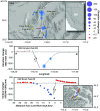From coseismic offsets to fault-block mountains
- PMID: 28847962
- PMCID: PMC5604041
- DOI: 10.1073/pnas.1711203114
From coseismic offsets to fault-block mountains
Abstract
In the Basin and Range extensional province of the western United States, coseismic offsets, under the influence of gravity, display predominantly subsidence of the basin side (fault hanging wall), with comparatively little or no uplift of the mountainside (fault footwall). A few decades later, geodetic measurements [GPS and interferometric synthetic aperture radar (InSAR)] show broad (∼100 km) aseismic uplift symmetrically spanning the fault zone. Finally, after millions of years and hundreds of fault offsets, the mountain blocks display large uplift and tilting over a breadth of only about 10 km. These sparse but robust observations pose a problem in that the coesismic uplifts of the footwall are small and inadequate to raise the mountain blocks. To address this paradox we develop finite-element models subjected to extensional and gravitational forces to study time-varying deformation associated with normal faulting. Stretching the model under gravity demonstrates that asymmetric slip via collapse of the hanging wall is a natural consequence of coseismic deformation. Focused flow in the upper mantle imposed by deformation of the lower crust localizes uplift, which is predicted to take place within one to two decades after each large earthquake. Thus, the best-preserved topographic signature of earthquakes is expected to occur early in the postseismic period.
Keywords: Basin and Range; crustal deformation; earthquakes; finite-element modeling; rifting.
Conflict of interest statement
The authors declare no conflict of interest.
Figures





References
-
- Colgan JP, Dumitru TA, Miller EL. Diachroneity of Basin and Range extension and Yellowstone hotspot volcanism in northwestern Nevada. Geology. 2004;32:121–124.
-
- Martel SJ, Stock GM, Ito G. Mechanics of relative and absolute displacements across normal faults, and implications for uplift and subsidence along the eastern escarpment of the Sierra Nevada, California. Geosphere. 2014;10:243–263.
-
- Colgan JP, Shuster DL, Reiners PW. Two-phase Neogene extension in the northwestern Basin and Range recorded in a single thermochronology sample. Geology. 2008;36:631–634.
-
- Compton RR. Analysis of Pliocene-Pleistocene deformation and stresses in northern Santa Lucia Range, California. Bull Geol Soc Am. 1966;77:1361–1380.
-
- Hammond WC, Blewitt G, Li Z, Plag H-P, Kreemer C. Contemporary uplift of the Sierra Nevada, western United States, from GPS and InSAR measurements. Geology. 2012;40:667–670.
LinkOut - more resources
Full Text Sources
Other Literature Sources

